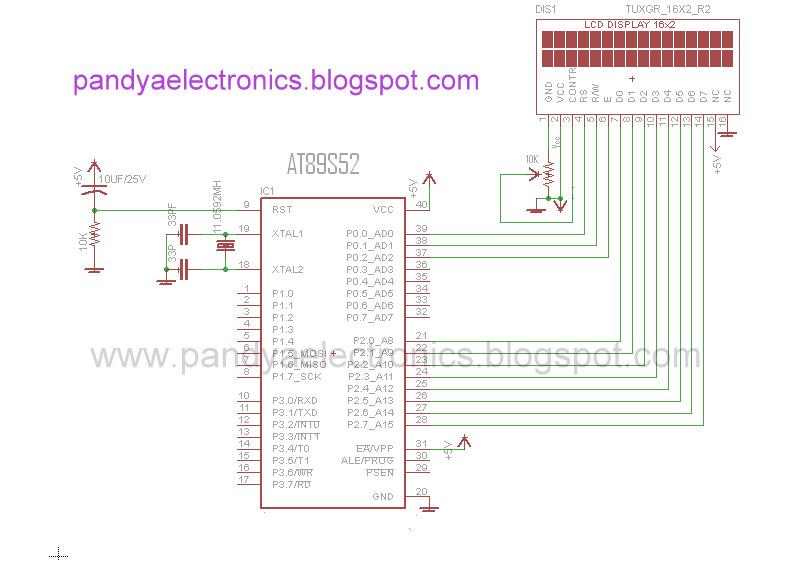General purpose input output (GPIO) is same thing you find in any microcontroller like 8051, avr etc.
Lpc2148 have two General Purpose I/O ports port 0
& port1.port0 & port1 both are 32-bit bi-directional ports like 8051
has four 8-bit bi-directional ports.
In port0,
P0.24, P0.26, P0.27 are not physically available means you can’t find
them on chip but still you can write values to them. & P0.31 is available
for digital output only.
Also this port has many alternate functions like 8051.
In port1,
P1.0 to P1.15 is not available physically. Only P1.16 to P1.31 is available.
So out of 64 pins 45 pins are covered by port0 & port1.
How to program ports?
Now let’s understand how to program these ports. There are 4 resisters
you need to understand to access these ports
IOPIN
|
For
port0 use IOPIN0 & for port1 use IOPIN1.you can also write IO0PIN &
IO1PIN both things are same.
Function:
GPIO Port Pin value
registers. The current state of the GPIO configured port pins can always be
read from this register, regardless of pin direction.
|
IOSET
|
For
port0 use IOSET0 & for port1 use IOSET1.again you can also write IO0SET
& IO1SET both things are same.
Function:
GPIO Port Output Set registers.
This register controls the state of output pins in conjunction with the IOCLR
register. Writing ones produces highs at the corresponding port pins. Writing
zeroes has no effect.
|
IODIR
|
For
port0 use IODIR0 & for port1 use IODIR1.again you can also write IO0DIR
& IO1DIR both things are same.
Function:
GPIO Port Direction
control register. This register individually controls the direction of each
port pin.
|
IOCLR
|
For
port0 use IOCLR0 & for port1 use IOCLR1.again you can also write IO0CLR
& IO1CLR both things are same.
Function:
GPIO Port Output Clear registers.
This
Register controls the
state of output pins. Writing ones produces lows at the
corresponding port pins
and clears the
Corresponding bits in the
IOSET register.
Writing
zeroes has no effect.
|
Let’s understand some C
program:
We will understand GPIO & register using some C
program. First of all remember that header file for lpc2148 is “lpc214x.h” like
reg51.h for 8051.
1) Blinking LED using IODIR,
IOCLR, and IOSET:
My development board has an LED at P0.21 so we are going
to use this LED for our example you can also run this program in Kiel debugger.
Program:
#include<lpc214x.h>
void wait(void) //generate small delay
{int
d;
for(d=0;d<1000000;d++);
}
int main(void)
{
IODIR0=0x00200000; //set P0.21
as output port
while(1)
{
IOSET0=0x00200000; //set p0.21
wait();
IOCLR0=0x00200000; //clr p0.21
wait();
}}
|
Explanation:
In this program first we select we select which pin will
be output & which pin will be input by using IODIR0.remember
0=input,1=output.
Then we write 1(high) to that pin using IOSET0 register.
Remember writing 0 to any bit of IOSET0 have no effect on port pin but writing
1 will produce high on corresponding port pin.
Then we write 0(low) to that pin using IOCLR0 register.
Remember writing 0 to any bit of IOCLR0 have no effect on port pin but writing
1 will produce low on corresponding port pin.
Ok, here we complete our first program I know there may
be lots of questions in your mind like why can’t we do P0=0x00200000,P0=0x00000000 as
we do in 8051 and why we write entire word(32-bit data=word) why we can’t do sbit mybit P0^21 as we do in 8051.
So fact is that both of these things don’t work on ARM
but there are ways to do something like that. Let’s see how to do this.
2) How to do sbit mybit
P0^21 i.e. address a single bit rather addressing entire register.
First of all keep in mind that there is no keyword like “sbit” in ARM c programming. But we can
do this by using “<<”
operator. This operator shifts the value on its left side to left by 1 bit by
the value specified on its right side.
So now suppose we want to produce 0x00200000 you
can just write (0<<21) both will be same.
Program:
#include<lpc214x.h>
void wait(void) //generate small
delay
{int d;
for(d=0;d<1000000;d++);
}
int main(void)
{
IODIR0=(1<<21); //set P0.21 as output port
while(1)
{
IOSET0=(1<<21); //set p0.21
wait();
IOCLR0=(1<<21); //clr p0.21
wait();
}
}
|
3) how to do
P0=0x00200000,P0=0x00000000.
Well there is no register like P0 ( 8051 ) in ARM. But there is a
register called IOPIN0 which do very much similar task as P0.what
ever value you write to IOPIN register will directly appear on physical
pins. & you can also read IOPIN register to know the status on pins.
Program:
#include <LPC214X.H>
void wait()
{
int d;
for(d=0;d<1000000;d++);
}
int main()
{
IODIR0=0x00200000;
while(1)
{
IOPIN0 =0x00200000;
wait();
IOPIN0 =0x00000000;
wait();
}}
|
4) Let's try to read input
also
Till now we have only seen output. But let’s include some input
also. My development board has a button on P0.15 . So let's make a program in which LED
will be turned on when there is high on P0.15 and when there is low on P0.15 LED will
be off.
Program:
#include<lpc214x.h>
int main()
{
IODIR0=(1<<21);
IODIR0&=~(1<<15);
while(1)
{
if(!(IOPIN0&(1<<15)))
{
IOCLR0=(1<<21);
}
if(IOPIN0&(1<<15))
{
IOSET0=(1<<21);
}
}
}
|









